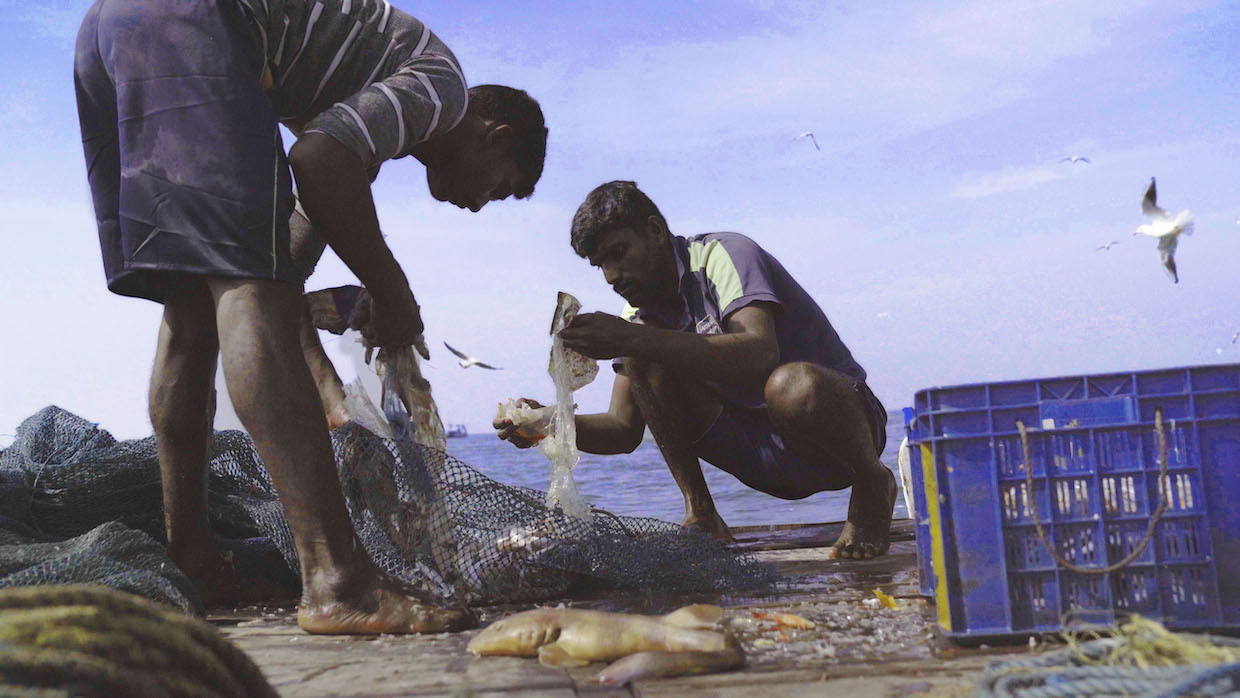 Back to selection
Back to selection
“The Sea Has Always Been Sensual and Angry”: DP Ashok Meena on Against the Tide
 Against the Tide, courtesy of Sundance Institute.
Against the Tide, courtesy of Sundance Institute. Two best friends struggle to make a living as fishermen in Bombay’s Indigenous Koli community in Against the Tide, director Sarvnik Kaur’s documentary that explores the impact of pollution, invasive species and other environmental factors contributing to a region’s dwindling fish population.
DP Ashok Meena discusses her experience working on the project, including the influence that Iranian cinema has had on her work.
See all responses to our annual Sundance cinematographer interviews here.
Filmmaker: How and why did you wind up being the cinematographer of your film? What were the factors and attributes that led to your being hired for this job?
Meena: Eye! Everyone has one eye that everyone sees, everyone can change the way they see. Whatever is seen, heard, felt, all of it has some meaning. If you start seeing, hearing and understanding that meaning in pictures, in voices, then a picture starts to be created.
Energy! Energy of being in the sea. Getting to know this fisherman community on the seashore of Mumbai very closely has been one of the reasons why I wanted to do this film. The sea has always been sensual and angry for me and this may be what drew me to this film. The main reason for connecting with any story is also to find self-reflection so that you can progress in your own thinking according to the story.
Filmmaker: What were your artistic goals on this film, and how did you realize them? How did you want your cinematography to enhance the film’s storytelling and treatment of its characters?
Meena: I always think of documentary as fiction and fiction as documentary when it comes to images. The story of the two friends in this film, which was shot over close to four years, takes so many ups and downs, as well as the presence of the sea, which feels very intense. My main goal was to see so much energy in a calm manner. Every effort was made to keep static and use long shots in the film. I almost always used a tripod. The selection of lensing according to different scenes was also very important. The characters Rakesh, Ganesh and the family are seen very closely in the film. Rakesh’s house is raw and is a big square room connected to a small kitchen with an open toilet and a big space outside the house. And the interior of the house is made like the open ground; everything happens on the floor. From here the camera starts moving closer to the characters as the camera and Rakesh’s family show the intimacy saved. Ganesh’s home is a house with a modern flat structure. The intimacy of the camera remains with Ganesh as well, but it sometimes takes an observational form.
Filmmaker: Were there any specific influences on your cinematography, whether they be other films, or visual art, or photography, or something else?
Meena: I have always been influenced by Iranian cinema in which fantasy is so close to reality. This is why Iranian cinema always feels closer to you. All the characters in the films are shown with perfect effect. They do not need to act; it happens automatically. That is, the method is that there are people in a house and there are their things.
Filmmaker: What were the biggest challenges posed by production to those goals?
Meena: Entering the sea is a big challenge and especially with the shooting crew. Security is a concern. Carrying equipment on a small boat to sea is a risky and challenging move. Still, it was possible.
Filmmaker: What camera did you shoot on? Why did you choose the camera that you did? What lenses did you use?
Meena: We have used Sony a7SII and Sony a7SIII cameras for this film. This is a very small DSLR size camera. We didn’t want to use a big camera. The community of fishermen in the film is a very secluded community. With a small camera, you can go on a boat and stand with it anywhere and be unobtrusive. I have always used Sony G master block lenses as well as Sony 16-35mm, 35-70mm and 27-200mm zoom lenses.
Filmmaker: Describe your approach to lighting.
Meena: The film is mostly shot in available light. I was aware that I should not change the house light because I don’t want to create a new atmosphere for the characters. A minimised lighting setup was used in some places. Nowadays we have these smart and small MC Kits lights by Apurture that were useful to keep handy on a documentary setup.
Filmmaker: What was the most difficult scene to realize and why? And how did you do it?
Meena: It is hard to say which was the most difficult scene but when Rakesh goes for monsoon fishing when the sea was in full swing was one. Fishing is sometimes restricted. But Rakesh and other small fishermen go for this kind of fishing. I decided to go fishing with them while the rest of the crew waited on shore.
Filmmaker: Finally, describe the finishing of the film. How much of your look was “baked in” versus realized in the DI?
Meena: It was graded at Gump Studios in Paris, where I found Nicolas, the grading artist. Nicholas’s contribution was very important. Nicholas had never come to India, so understanding this concept was a bit challenging, but once understood, it became very easy. The film was not changed in any way. Its form has been kept original.
TECH BOX
Film Title: Against the Tide
Camera: SONY a7sII / SONY a7sIII
Lenses: Sony G Master 24mm, 50mm, 85mm/ 16-35mm, 24-70mm, 70-200mm
Lighting: Practical Sources Only / Apurture MC Kit
Color Grading: Davinci Resolve
